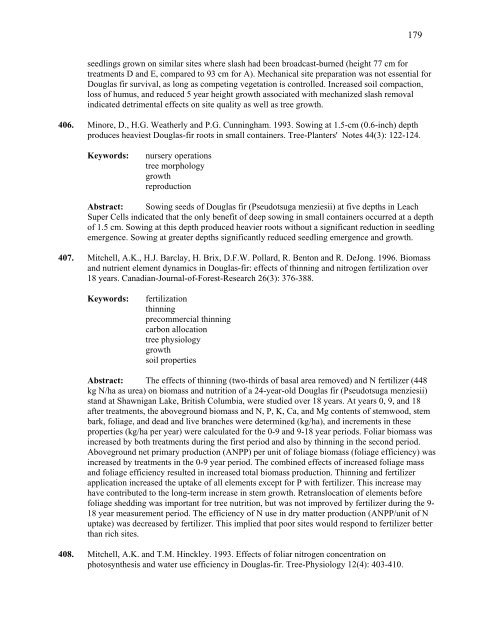IntensIve sIlvIculture - Forest Science Labs - Research Network ...
IntensIve sIlvIculture - Forest Science Labs - Research Network ...
IntensIve sIlvIculture - Forest Science Labs - Research Network ...
You also want an ePaper? Increase the reach of your titles
YUMPU automatically turns print PDFs into web optimized ePapers that Google loves.
179<br />
seedlings grown on similar sites where slash had been broadcast-burned (height 77 cm for<br />
treatments D and E, compared to 93 cm for A). Mechanical site preparation was not essential for<br />
Douglas fir survival, as long as competing vegetation is controlled. Increased soil compaction,<br />
loss of humus, and reduced 5 year height growth associated with mechanized slash removal<br />
indicated detrimental effects on site quality as well as tree growth.<br />
406. Minore, D., H.G. Weatherly and P.G. Cunningham. 1993. Sowing at 1.5-cm (0.6-inch) depth<br />
produces heaviest Douglas-fir roots in small containers. Tree-Planters' Notes 44(3): 122-124.<br />
Keywords: nursery operations<br />
tree morphology<br />
growth<br />
reproduction<br />
Abstract: Sowing seeds of Douglas fir (Pseudotsuga menziesii) at five depths in Leach<br />
Super Cells indicated that the only benefit of deep sowing in small containers occurred at a depth<br />
of 1.5 cm. Sowing at this depth produced heavier roots without a significant reduction in seedling<br />
emergence. Sowing at greater depths significantly reduced seedling emergence and growth.<br />
407. Mitchell, A.K., H.J. Barclay, H. Brix, D.F.W. Pollard, R. Benton and R. DeJong. 1996. Biomass<br />
and nutrient element dynamics in Douglas-fir: effects of thinning and nitrogen fertilization over<br />
18 years. Canadian-Journal-of-<strong>Forest</strong>-<strong>Research</strong> 26(3): 376-388.<br />
Keywords: fertilization<br />
thinning<br />
precommercial thinning<br />
carbon allocation<br />
tree physiology<br />
growth<br />
soil properties<br />
Abstract: The effects of thinning (two-thirds of basal area removed) and N fertilizer (448<br />
kg N/ha as urea) on biomass and nutrition of a 24-year-old Douglas fir (Pseudotsuga menziesii)<br />
stand at Shawnigan Lake, British Columbia, were studied over 18 years. At years 0, 9, and 18<br />
after treatments, the aboveground biomass and N, P, K, Ca, and Mg contents of stemwood, stem<br />
bark, foliage, and dead and live branches were determined (kg/ha), and increments in these<br />
properties (kg/ha per year) were calculated for the 0-9 and 9-18 year periods. Foliar biomass was<br />
increased by both treatments during the first period and also by thinning in the second period.<br />
Aboveground net primary production (ANPP) per unit of foliage biomass (foliage efficiency) was<br />
increased by treatments in the 0-9 year period. The combined effects of increased foliage mass<br />
and foliage efficiency resulted in increased total biomass production. Thinning and fertilizer<br />
application increased the uptake of all elements except for P with fertilizer. This increase may<br />
have contributed to the long-term increase in stem growth. Retranslocation of elements before<br />
foliage shedding was important for tree nutrition, but was not improved by fertilizer during the 9-<br />
18 year measurement period. The efficiency of N use in dry matter production (ANPP/unit of N<br />
uptake) was decreased by fertilizer. This implied that poor sites would respond to fertilizer better<br />
than rich sites.<br />
408. Mitchell, A.K. and T.M. Hinckley. 1993. Effects of foliar nitrogen concentration on<br />
photosynthesis and water use efficiency in Douglas-fir. Tree-Physiology 12(4): 403-410.
















